
Our second trip was occasioned by a visit to our son, Matthew, in C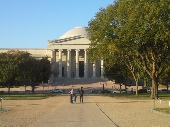 ollege Park, MD (D.C. area). Since we were planning a bike trip at that time anyway, it seemed natural to extend our Pittsburgh to D.C. trip we made the previous year and ride on to the Big Apple. This, in turn, led to the thought of extending the trip westward in subsequent bike trips, and the cross country vision was born.
ollege Park, MD (D.C. area). Since we were planning a bike trip at that time anyway, it seemed natural to extend our Pittsburgh to D.C. trip we made the previous year and ride on to the Big Apple. This, in turn, led to the thought of extending the trip westward in subsequent bike trips, and the cross country vision was born.
T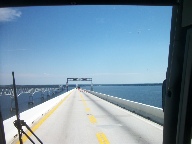 he first challenge facing one trying to go from D.C. to the coast is crossing Chesapeake Bay. If you’ve been there, you know that the only way across is over the Chesapeake Bay bridge, which is off limits to bikes. Thankfully, a local bus runs over the bridge and takes bikes collapsed into bike bags (they’ll take the riders, too). The bridge must be one of the most amazing in the world for length, beauty and engineering genius. Too bad we couldn’t ride it.
he first challenge facing one trying to go from D.C. to the coast is crossing Chesapeake Bay. If you’ve been there, you know that the only way across is over the Chesapeake Bay bridge, which is off limits to bikes. Thankfully, a local bus runs over the bridge and takes bikes collapsed into bike bags (they’ll take the riders, too). The bridge must be one of the most amazing in the world for length, beauty and engineering genius. Too bad we couldn’t ride it.
Af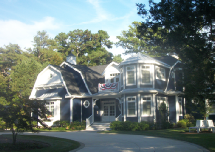 ter landing in eastern Maryland we couldn’t help stopping at a bayside café and sampling their seafood. A real treat. Scott Pitner provides a great itinerary for crossing eastern Maryland and Delaware on scenic, low traffic roads, which we included in our total itinerary (see http://www.yourgreatadventure.net/dc_nyc.html). The route takes you through rural countryside, yet the farmhouses remind one of miniature southern plantations.
ter landing in eastern Maryland we couldn’t help stopping at a bayside café and sampling their seafood. A real treat. Scott Pitner provides a great itinerary for crossing eastern Maryland and Delaware on scenic, low traffic roads, which we included in our total itinerary (see http://www.yourgreatadventure.net/dc_nyc.html). The route takes you through rural countryside, yet the farmhouses remind one of miniature southern plantations.
We we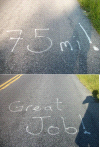 re in for quite a shock when, after exactly 75 miles of riding, we crossed over some writing on the road that said “75 miles,” and then a little later, “Great job!” The thing is, that even if someone else had taken Scott Pitner’s route they wouldn’t have done 75 miles at that point, since we made several adaptations to it. Also, 75 miles is not likely the distance to D.C. since we started from College Park. Who wrote that, for whom, and why will ever remain a mystery. But we took it as personal encouragement for us!
re in for quite a shock when, after exactly 75 miles of riding, we crossed over some writing on the road that said “75 miles,” and then a little later, “Great job!” The thing is, that even if someone else had taken Scott Pitner’s route they wouldn’t have done 75 miles at that point, since we made several adaptations to it. Also, 75 miles is not likely the distance to D.C. since we started from College Park. Who wrote that, for whom, and why will ever remain a mystery. But we took it as personal encouragement for us!
After a pleasant ride East we arrived at the mighty Atlantic. Sinc e bikes don’t float very well, we boarded a ferry at Lewes, DE after spending the night at Cape Henlopen State Park, which is almost worth the trip itself. The park has some great scenic trails and we even caught an outdoor movie -
e bikes don’t float very well, we boarded a ferry at Lewes, DE after spending the night at Cape Henlopen State Park, which is almost worth the trip itself. The park has some great scenic trails and we even caught an outdoor movie -
The ferry takes yo u to Cape May, NJ, where you begin your trip up the New Jersey coast. The Cape itself features an impressive lighthouse, one of many along the coast. On the way there we were able to help a fellow cyclist, who was walking his wounded bike along the road, and after a quick repair he returned the favor by taking us by the best route to the lighthouse.
u to Cape May, NJ, where you begin your trip up the New Jersey coast. The Cape itself features an impressive lighthouse, one of many along the coast. On the way there we were able to help a fellow cyclist, who was walking his wounded bike along the road, and after a quick repair he returned the favor by taking us by the best route to the lighthouse.
On the New Jersey coast, beach life rules, with numerous bo ardwalks, cafes, endless swimming beaches and lots of people to enjoy them. The coastline is also dotted with ocean side mansions. Tom was impressed by how green New Jersey is. Somehow he grew up with the impression that New Jersey, and the east coast in general, was pure concrete from top to bottom.
ardwalks, cafes, endless swimming beaches and lots of people to enjoy them. The coastline is also dotted with ocean side mansions. Tom was impressed by how green New Jersey is. Somehow he grew up with the impression that New Jersey, and the east coast in general, was pure concrete from top to bottom.
The northern tip 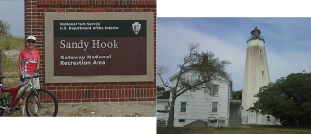 of the New Jersey coast is punctuated by Sandy Hook, a peninsula which extends from the south into New York harbor. There stands old Fort Hancock, which used to guard the harbor, and also the oldest working lighthouse in the U.S. A ferry brings city folks from the stuffy, crowded metropolis to the sunny beaches of Sandy Hook.
of the New Jersey coast is punctuated by Sandy Hook, a peninsula which extends from the south into New York harbor. There stands old Fort Hancock, which used to guard the harbor, and also the oldest working lighthouse in the U.S. A ferry brings city folks from the stuffy, crowded metropolis to the sunny beaches of Sandy Hook.
An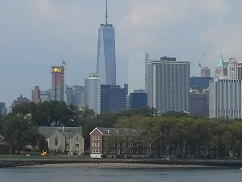 d it’s the ferry that brought this segment of our journey to an end in New York City. The eastern endpoint had been reached. All that remained now was getting from Pittsburgh to the Pacific! One final remarkable event. We typically bus back to our starting point, and on this trip the bus blew a tire inside the Baltimore Harbor Tunnel. As you know, there’s no direction to go in a tunnel except straight, and the bus driver did a masterful job keeping the bus on the road, maneuvering it in tight traffic and getting it out of the tunnel.
d it’s the ferry that brought this segment of our journey to an end in New York City. The eastern endpoint had been reached. All that remained now was getting from Pittsburgh to the Pacific! One final remarkable event. We typically bus back to our starting point, and on this trip the bus blew a tire inside the Baltimore Harbor Tunnel. As you know, there’s no direction to go in a tunnel except straight, and the bus driver did a masterful job keeping the bus on the road, maneuvering it in tight traffic and getting it out of the tunnel.